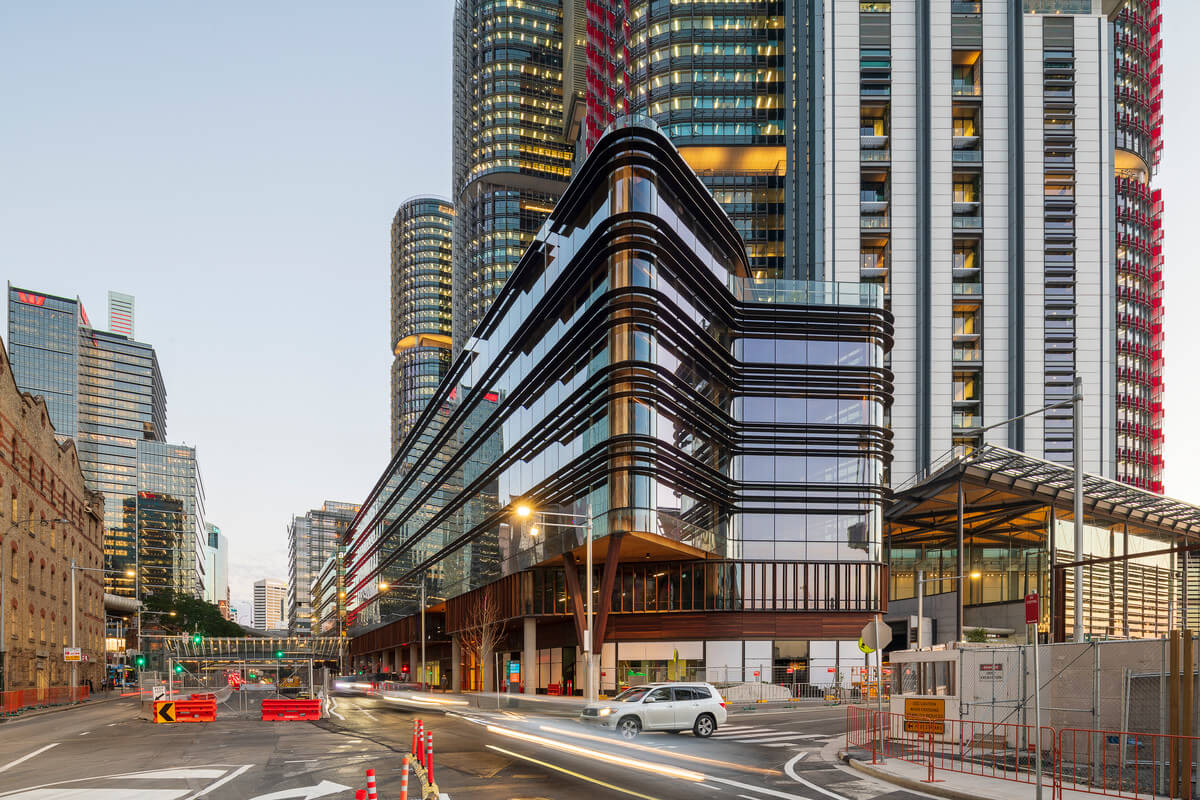
This piece was written and provided by FTMA Supporting Partner, Stora Enso.
Just completed in 2022, the largest mass timber building in Asia—the Nanyang Technological University (NTU) is set to open its doors for the first time (pictured right). The 42 000 m² megastructure spans six stories and incorporates 7 700 m³ of Stora Enso’s sustainable cross-laminated timber (CLT), joining the ranks of the largest low-carbon buildings in the world.
In neighbouring Australia, building with wood is a thriving and developing industry, particularly for single-family homes and smaller unit development (3-4 storeys) but CLT is relatively new for commercial construction.
Pictured Right: Nanyang Technological University, Academic Building South (NTU ABS)—Asia’s largest mass engineered timber project in Singapore (occupies 42 000 m²). Completed: 2022
Photo: Steeltech Industries PTE Ltd. Architects: Toyo Ito & Associates
For a long time, Australian home builders have sourced their wood from European forests for their construction needs. The colder Nordic and central European climates allow the wood to grow slowly and produce some of the finest top-grade wood in the world. Highly regulated certification standards well established in Europe provide an additional layer of consumer assurance for traders keen to reduce climate-damaging carbon-dioxide emissions from their projects. Such efforts have been recently bolstered by Prime Minister Anthony Albanese’s Climate Change Bill that legislates a 43% cut to carbon dioxide emissions from 2005 levels by 2030 and will increase the demand for more timber projects, (the construction industry alone accounts for 37% of polluting carbon emissions).

For a long time, Australian home builders have sourced their wood from European forests for their construction needs. The colder Nordic and central European climates allow the wood to grow slowly and produce some of the finest top-grade wood in the world. Highly regulated certification standards well established in Europe provide an additional layer of consumer assurance for traders keen to reduce climate-damaging carbon-dioxide emissions from their projects. Such efforts have been recently bolstered by Prime Minister Anthony Albanese’s Climate Change Bill that legislates a 43% cut to carbon dioxide emissions from 2005 levels by 2030 and will increase the demand for more timber projects, (the construction industry alone accounts for 37% of polluting carbon emissions).
Besides the environmental benefits, Australians are choosing wood for a host of practical construction benefits and positive health reasons. Construction sites enjoy a substantial reduction in noise, dust and vibrations and require far fewer skilled workers onsite. Building with wood is proven to be safer and cuts deliveries by 80%. It is also cost competitive with steel and concrete. Several scientific studies prove that natural properties of wood lower your heart rate, boost your concentration, and generally create a warm and inviting interior space making it a very attractive choice. Buyers are typically willing to pay a higher price to live and work in wooden buildings making it more profitable too.
An issue in the past has been sourcing sustainable wood in Australia. Stora Enso, as one of the world’s largest private forest owners and sawnwood producers with 16 sawmills and a sawing capacity of 5.5 million m³ per year, is making significant inroads to transform this situation. When shipping to Singapore, for instance, for the NTU project their 47 precision-flat-packed shipments were delivered all just in time (JIT). Not an inch of space was wasted and not one element was faulty or had to be returned.
Interestingly, Stora Enso’s main competitors are not other saw-milling and timber companies or even other wood products providers. Their main competition resides within the concrete and steel manufacturing industries. “We strive to provide alternatives to fossil-based materials such as concrete, steel and plastic. We believe that everything made from fossil-based materials today can be made from a tree tomorrow,” explains Lars Völkel, Executive Vice President Stora Enso’s Wood Products.
By replacing one cubic meter of concrete with wood, you can save a tonne of CO₂, (Hamburg University) while substituting the same volume of steel with wood, you’re looking at two and a half tonnes of CO₂. “These substantial savings in carbon emissions are the biggest competitive differentiator we have within our industry,” explains Lars Völkel.

Photo: Stora Enso offers an extensive range of high-quality classic sawn and planed timber of varying dimensions and lengths and can be produced to exact requirements.
Alongside solid structural timber and CLT, Stora Enso also produces Laminated Veneer Lumber (LVL) and prefabricated building elements (Sylva™), all complemented with experiential expertise, digital tools and building concepts. If you are new to working with wood or want to increase your profitability on building projects, we can provide architectural building concepts that will ensure the highest optimisation of the entire raw material.
Stora Enso’s global positioning bolsters its ranking as an industry leader with sawmills utilising the latest technology and selecting premium raw materials for each end use reducing handling costs and wood waste. Since Stora Enso has total control over the supply chain from the forest to client’s front door, customers get reliable delivery and all-around high quality. And, Stora Enso regrows more trees than they harvest and have set a target for 2050 to be completely regenerative in all their operations.
“We are poised to enable more buildings in Australia utilising wood, especially in multi-story or commercial structures. Yes, building regulations are complex, but we are seasoned in this market and can assist project decision-makers everywhere in the world, including Australia, from smaller residential projects to large megastructures,” said Darrin Wheeler, Melbourne-based Area Sales Director for Stora Enso.
Stora Enso has already supplied wood for Lendlease with the construction of International House Sydney, Australia´s first wooden office (2 454 m³ of CLT), the 9-storey office block at 25 King Street, Brisbane (6 270m³ CLT) and Melbourne’s first CLT public building: The Library at the Dock.


Photo Left: International House Sydney, Australia
Developer: Lendlease, Architect: Tzannes Associates
Photo Right: 25 King Street, Brisbane, Australia
Stora Enso Partner: Lendlease, Developer: Impact Investment Group
Architect: Bates Smart, Photo: Lendlease
6 270m³ of responsibly sourced timber constructed in 15 months. The 9-storey plus ground superstructure utilises a combination of revolutionary engineered cross-laminated timber (CLT) and glulam (glue laminated timber).
“We feel a sense of duty to share our knowledge within the construction industry, and further support our contractors with not only raw materials and digital tools, not just because it is easier than many think to build with wood but because we all have a part to play in building better for tomorrow and changing how we build can have the biggest impact today,” finished Darrin Wheeler.
Tech specs at a glance for Australia
Thickness 35, 45 mm
Widths 70, 90, up to 190 mm
Lengths 2.4–6.0 m
Wood species Spruce and pine
Moisture content 12% ± 2%
Grades F5, F8, MGP10, MGP12
Produced in Austria, Czech Republic, Estonia, Finland, Lithuania, Poland and Sweden
Visit us at Stora Enso and learn more about our wood products available in Australia

Part of the bioeconomy, Stora Enso is a leading global provider of renewable solutions in packaging, biomaterials, wooden constructions, and paper. We believe that everything that is made from fossil-based materials today can be made from a tree tomorrow. Stora Enso has some 21 000 employees and our sales in 2022 were 11,680 million EUR Stora Enso shares are listed on Nasdaq Helsinki Oy (STEAV, STERV) and Nasdaq Stockholm AB (STE A, STE R). In addition, the shares are traded in the USA as ADRs (SEOAY). storaenso.com
Our Principal Partners



